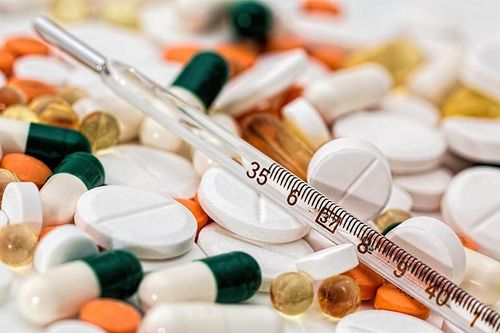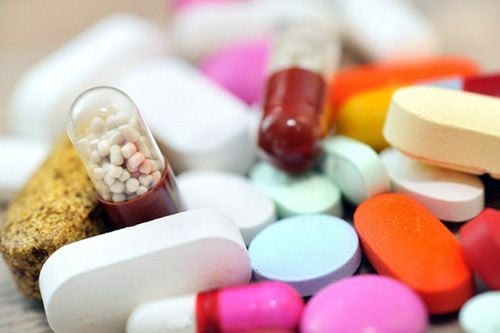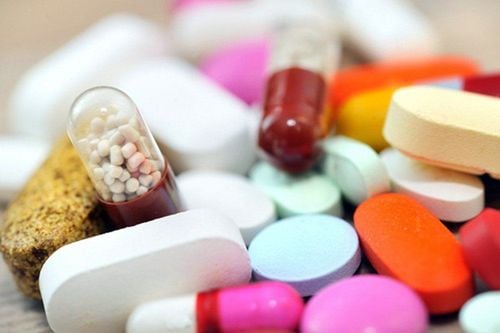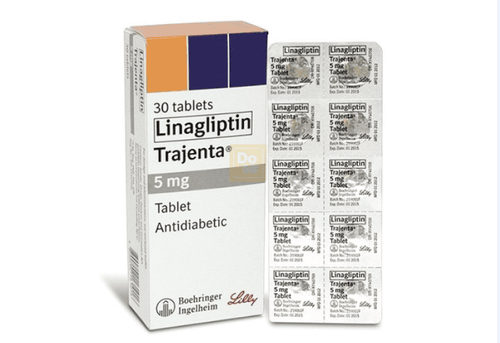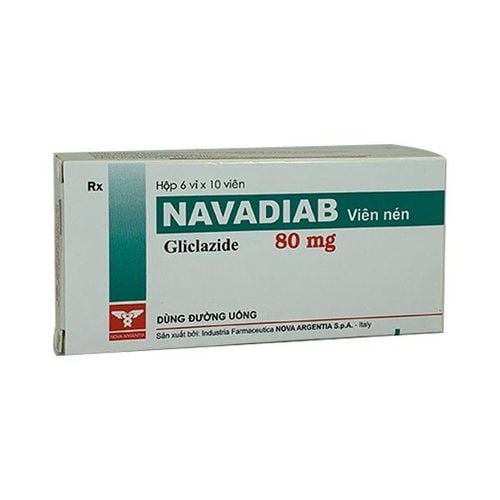This is an automatically translated article.
Amdiaryl 4 has the active ingredient glimepiride, belongs to the 2nd generation Sulfonylurea group, is used to treat patients with type 2 diabetes (non-insulin dependent) in combination with diet and exercise.
1. What are the uses of Amdiaryl 4?
1.1. What is Amdiaryl 4? Amdiaryl 4 belongs to the group of Hormonal and Hormonal drugs, with registration number VD-28319-17, manufactured by Ampharco Pharmaceutical Joint Stock Company U.S.A - Vietnam.
Amdiaryl 4 drug includes the following ingredients:
Main active ingredient: Glimepiride 4mg. Excipients: Lactose, sodium starch glycolate, microcrystalline cellulose PH 101 (Avicel PH 101), povidone K 25 (Kollidon K25), magnesium stearate, burgundy indigo carmine aluminum (E 132). The drug is prepared in the form of 4mg filter-coated tablets; blister of 10 tablets, box of 1 blister, 3 blisters, 6 blisters or 10 blisters.
Amdiaryl 4 is recommended for use in adults.
1.2. What is Amdiaryl 4 used for? Amdiaryl 4 is indicated for the following:
An adjunct to diet and exercise to reduce blood glucose levels in adult type 2 diabetic patients when diet and exercise Exercise alone cannot help control hyperglycemia. Concomitant use with Metformin during diet and exercise. When a single dose of Amdiaryl 4 or Metformin does not control blood sugar as expected. Use in combination with insulin to lower blood sugar in patients whose hyperglycemia cannot be controlled with diet and regular exercise, in combination with oral hypoglycemic agents. Amdiaryl 4 is contraindicated in the following cases:
Patients who are allergic to Glimepiride, Sulfamide, Sulfonylurea or any of the excipients of the drug. Type 1 diabetes. Ketosis due to complications of diabetes mellitus. Pre-coma or coma due to complications of diabetes. Severe kidney failure or severe liver failure. Breastfeeding or pregnant.
2. Usage of Amdiaryl 4
2.1. How to take Amdiaryl 4 Amdiaryl 4 is taken orally. Should be taken with food: Take immediately before a light meal or main meal in the morning. Patients must absolutely not skip meals after taking Amdiaryl 4. 2.2. Dosage of Amdiaryl 4 The initial dose and maintenance dose are determined based on the results of the patient's blood sugar and urine sugar tests. Reference doses are as follows:
Adults: The starting dose for previously untreated patients is 1 to 2 mg/day. Debilitated, malnourished, hepatic, or renal insufficiency, or the elderly, patients at risk of hypoglycaemia, take 1mg/day. In patients previously treated with other antidiabetic agents, the dose is 1 to 2 mg/day, up to a maximum dose of 2 mg/day. Maintenance dose: 1 to 4 mg/day (for patients already taking glimepiride 1 mg `day, increase to 2 mg/day if desired blood glucose levels are still not achieved after 1 to 2 weeks of treatment.) 2 mg, then titration is based on patient response and tolerability). The oral dose should be increased slowly, each increment not exceeding 2 mg/day, at 1- to 2-week intervals. Maximum 8mg/day. Use of Amdiaryl 4 with Metformin:
When blood glucose cannot be controlled with the maximum daily dose of Amdiaryl 4 or when a single dose of metformin-containing antidiabetic drugs is used, both drugs can be used together. . In that case, the dose of the drug taken remains unchanged. Start treatment with Amdiaryl 4 at a low dose, depending on the desired blood glucose level, and then gradually increase until the maximum daily dose. The initiation of combination therapy requires the supervision of a specialist. Using combination of Amdiaryl 4 with Insulin:
When blood sugar cannot be controlled with the maximum daily dose of Amdiaryl 4, it can be used in combination with insulin. Applied to this case, the dose of Amdiaryl 4 currently used remains unchanged. Start insulin therapy at a low dose, then increase it gradually according to the desired blood glucose level. The initiation of combination therapy requires the supervision of a specialist. Long-term effectiveness should be monitored by measuring HbA1c levels, recommending testing every 3 to 6 months. Handling missed dose:
When forgetting to take a dose of Amdiaryl 4, do not make up for it with a higher dose. Absolutely do not skip meals after taking the medicine. Always carry at least 20g of sugar with you in case of hypoglycemia. It is necessary to strictly adhere to the diet still applicable. Treatment of Overdose:
Amdiaryl 4 overdose can lead to severe, sometimes life-threatening hypoglycemia, requiring hospitalization. Mild episodes of hypoglycemia are usually treated with oral carbohydrates. Amdiaryl 4 dosage, diet, and physical activity may need to be adjusted. More severe episodes of hypoglycaemia with convulsions, coma, or neurological damage should be treated with glucagon (subcutaneously or intramuscularly or intravenously) or with a hypertonic glucose solution. If a large overdose is potentially life-threatening, it should be detoxified immediately (by gastric lavage, vomiting, activated charcoal). Hypoglycemia may recur after the patient appears to have made a clinical recovery, requiring prolonged carbohydrate administration and follow-up monitoring. The patient's blood glucose should be closely monitored for at least 24 hours. In severe cases, you will need to continue to monitor your blood sugar for a few more days.
3. Note when using Amdiaryl 4
Amdiaryl 4 can be used short-term during periods of temporary loss of glycemic control in patients well controlled with diet and exercise. To achieve optimal blood sugar control, eating the right diet, exercising regularly and regularly, and if possible losing weight, is just as important as taking Amdiaryl 4 daily. During the first weeks of treatment, the risk of hypoglycemia may increase and should be monitored especially carefully. Hypoglycemia can be controlled almost immediately by using sugar in the form of glucose, sugar tablets or sugary soft drinks. Patients should always carry at least 20g of glucose with them for this purpose (artificially sweetened foods or beverages – such as diet foods that do not control hypoglycemia). When being treated by another physician (eg, when admitted to the hospital after an accident, ill on a holiday, the patient must inform the doctor about his or her diabetes and previous treatment) . In certain situations of extreme stress (eg, trauma, surgery, infection with fever) blood sugar control may be more difficult, and a temporary switch to insulin may be necessary. During treatment with Amdiaryl 4, fasting blood and urine glucose levels should be checked frequently, as well as the glycosylated hemoglobin ratio, usually every 3 to 6 months for a more accurate assessment. long-term glycemic control. Do not use for pregnant women, nursing mothers, drivers and operating machinery.
4. Side effects of Amdiaryl 4
At therapeutic doses, Amdiaryl 4 was well tolerated. However, during the use of Amdiaryl 4, patients may still experience side effects such as:
Hypoglycaemia:
Symptoms: Headache, raging hunger, nausea, vomiting, fatigue, drowsiness, sleep disturbance, restlessness, aggression, decreased concentration, decreased flexibility, decreased responsiveness, depression, confusion, speech disorder, aphasia, visual disturbance, tremor, paresis, sensory disturbance sensations, dizziness, exhaustion, loss of control, slurred speech, convulsions, somnolence and loss of consciousness leading to coma, shallow breathing and bradycardia. In addition, there may be symptoms of parasympathetic conditioning such as sweating, cold skin, anxiety, tachycardia, increased blood pressure, palpitations, angina, and arrhythmias. The clinical picture of a severe hypoglycaemic attack can resemble a stroke. Eyes:
Especially at the beginning of therapy there will be temporary visual disturbances due to changes in blood glucose levels. Gastrointestinal tract:
Occasionally nausea, vomiting, feeling of fullness or pressure in the epigastrium, abdominal pain, diarrhea and rarely discontinuation of treatment. In individual cases, there may be elevated liver enzymes or impaired liver function. Hematology:
Rare: Mild or severe thrombocytopenia. In individual cases: Hemolytic anemia, erythrocytopenia, leukopenia, agranulocytosis, agranulocytosis, 3 lineage reduction. In general, these effects disappear when the drug is stopped. Other side effects:
Occasionally: There are allergic or pseudo-allergic reactions such as rash, hives or redness. These mild allergic symptoms are most likely to develop into severe reactions with difficulty breathing, a drop in blood pressure, sometimes leading to shock. Therefore, when urticaria appears, it is necessary to notify the doctor immediately. In rare cases, there may be a decrease in plasma sodium concentration or the occurrence of allergic vasculitis and photosensitivity of the skin. If you experience these symptoms, the patient should stop using Amdiaryl 4 and notify the doctor for appropriate treatment.
5. Amdiaryl 4 . drug interactions
Amdiaryl 4 may have an interaction reaction if used concurrently with:
Oral diabetes drugs, insulin, chloramphenicol, monoamine oxidase inhibitors (MAOs), coumarin derivatives, phenylbutazone, miconazole, blockers increase the effect hypoglycemic effect of Amdiaryl 4. Acetazolamide, barbiturates, diuretics, phenytoin, glucagons reduce the effect of Amdiaryl 4. Antihistamines H2, reserpine, clonidine, alcohol: Alter the effect of Amdiaryl 4. To avoid Interaction status, before being prescribed Amdiaryl 4, the patient should inform the doctor about the drugs they are using, including functional foods. The doctor will base on that to prescribe the appropriate Amdiaryl 4.
6. How to store Amdiaryl 4
Amdiaryl 4 is stored for 18 months from the date of manufacture. Store Amdiaryl 4 below 30 degrees Celsius in a cool, dry place in the original packaging, avoiding direct sunlight to change the drug. Above is all information about Amdiaryl 4 drug, patients need to carefully read the instructions for use, consult a doctor / pharmacist before using. Absolutely do not arbitrarily buy Amdiaryl 4 for home treatment because there may be unwanted side effects.




